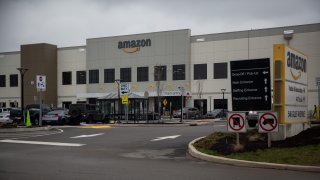
What to Know
- Amazon informed sellers on Saturday it will no longer restrict new product shipments by quantity.
- The company has also restored some services to its website, such as its featured deals section, coupons and the “Frequently bought together” widget on product pages, which were removed in an effort to prevent additional purchases as Amazon experienced a huge spike in demand.
- These are the latest signs that Amazon’s warehouses may be returning to normal and that delivery times are improving.
Amazon is removing restrictions on non-essential items at its warehouses and turning back on popular features of its site, marking the latest signs that it’s recovering from coronavirus-related delays.
The company started informing third-party sellers on Saturday that it would no longer limit new shipments of nonessential goods by quantity. Previously, Amazon had placed a “Limited Restock” tag on products shipped to Fulfillment by Amazon (FBA) warehouses, but as of this weekend, the label had been removed, meaning sellers can send in as much inventory as they want, said Juozas Kaziukenas, who runs the e-commerce market research firm Marketplace Pulse.
Kristen Kish, an Amazon spokeswoman, confirmed the company removed quantity restrictions on nonessential goods.
“We removed quantity limits on products our suppliers can send to our fulfillment centers,” Kish said. “We continue to adhere to extensive health and safety measures to protect our associates as they pick, pack and ship products to customers, and are improving delivery speeds across our store.”
Business Insider previously reported that Amazon lifted the restrictions on new FBA shipments. FBA is Amazon’s program that lets individual sellers ship their products to an Amazon warehouse, and Amazon ships the product to customers for a cut of each sale.
Jason Boyce, a former Amazon seller who is now a consultant to third-party merchants, told CNBC that all of his clients have had restrictions lifted on their products. “I’m not sure how long it will stay that way, but it is a hopeful sign for sellers,” he said.
Business
Before the change, Amazon had capped the number of units that sellers could send per order to its warehouses. For example, newer FBA listings were limited to 50 units per order. Sellers told CNBC the restrictions made it hard for them to keep up with a flurry of orders placed by shoppers during the pandemic and caused many popular products to run out of stock quickly.
Amazon has weathered a series of logistical nightmares during the coronavirus outbreak, as quarantined shoppers rushed to the site, panic buying toilet paper and hand sanitizer. In March, at the height of the pandemic, Amazon announced it was prioritizing shipments of household items and medical supplies at its warehouses, as it became overwhelmed with demand for these items.
The company has committed in more ways than one to get delivery times back to normal. Amazon said it would invest its expected $4 billion second-quarter profit on coronavirus-related expenses, including “getting products to customers and keeping employees safe.” But even with that spending, Amazon said it remains hard to predict when one- and two-day shipping would resume.
“Right now things are still so up in the air that I can’t really project when that day will be,” Amazon CFO Brian Olsavsky told investors on the company’s most recent earnings call earlier this month.
There are other signs that Amazon is beginning to balance demand for essential and nonessential items at its warehouses. Earlier this week, Amazon added back the featured deals section and coupons to its site, both of which were removed in an effort to prevent consumers from making additional purchases. Other features on its site, such as the “Frequently bought together” widget on product listings, were also restored this week.
Amazon’s online grocery delivery businesses are also beginning to resume normal service. Prime Pantry, which lets customers buy packaged groceries and household items, is now back online after it was temporarily shut down in March. Additionally, some new customers who sign up for Amazon Fresh or Whole Foods are no longer required to join a virtual wait list before they can use the services. Kish said more than 80% of eligible Prime members are able to buy groceries without requesting an invitation.
Next-day delivery is now starting to come back online for select cities in the U.S., Kaziukenas said, signaling that delivery times appear to be improving. However, until Amazon can restore its normally speedy one- and two-day shipping options for Prime subscribers, warehouses won’t be fully recovered, he added.
“Amazon has been in a race against the clock to restore fast shipping as without it it sent customers to look elsewhere,” Kaziukenas said. “It’s not done yet, but they appear past the April multi-week-long deliveries, at least for the most popular items.”
This story first appeared on CNBC.com. More from CNBC:



